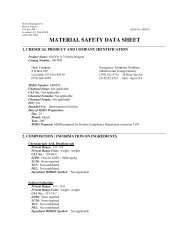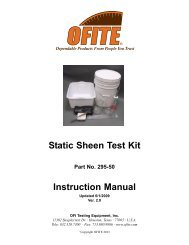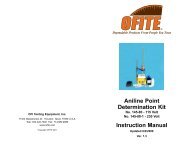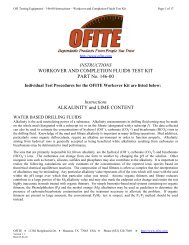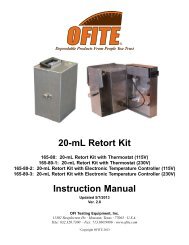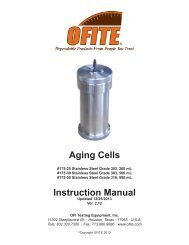chloride and water hardness (versenate) - OFI Testing Equipment, Inc.
chloride and water hardness (versenate) - OFI Testing Equipment, Inc.
chloride and water hardness (versenate) - OFI Testing Equipment, Inc.
You also want an ePaper? Increase the reach of your titles
YUMPU automatically turns print PDFs into web optimized ePapers that Google loves.
<strong>OFI</strong> <strong>Testing</strong> <strong>Equipment</strong> – 144-70 Instructions – Chloride Hardness Method Page 1of 5<br />
http://www.ofite.com<br />
INSTRUCTIONS<br />
CHLORIDE AND WATER HARDNESS (VERSENATE) METHOD<br />
<strong>OFI</strong>TE PART No. 144-70<br />
<strong>OFI</strong>TE • 11302 Steeplecrest Dr. • Houston, TX 77065 USA • Phone (832) 320-7300 • http://www.ofite.com<br />
Version 1.2<br />
Date 06-6-05
<strong>OFI</strong> <strong>Testing</strong> <strong>Equipment</strong> – 144-70 Instructions – Chloride Hardness Method Page 2of 5<br />
EQUIPMENT:<br />
QUANTITY DESCRIPTION PART NO.<br />
1 Titration Dish, Polyethylene 153-26<br />
2 Stirring Rods, Polyethylene 153-28<br />
2 1 ML Pipette 153-34<br />
2 10 ML Pipette 153-40<br />
1 Ver Hard Tit. Soln (1 ml = 2 epm) 16 Fl. Oz. 205-00<br />
1 Ver Hard Ind Soln., 2 Fl. Oz. 205-02<br />
1 Ver Hard Buffer Soln., 2 Fl. Oz. 205-04<br />
1 Ver Hard Tit Soln., (ml = 20epm) 8 Fl. Oz. 205-10<br />
1 Distilled Water, 16 Fl. Oz. 206-02<br />
1 Pot Chromate Ind. Soln., 4 Fl. Oz. 215-00<br />
1 Phenolphthalein Ind. Soln., 8 Fl. Oz. 220-00<br />
1 N/50 Sulfuric Acid Soln., 4 Fl. Oz. 203-17<br />
1 0.0282N Silver Nitrate Soln., 8 Fl. Oz. 265-00<br />
1 0.282N Silver Nitrate Soln., 8 Fl. Oz. 265-06<br />
CHLORIDE ION DETERMINATION:<br />
This test measures the soluble <strong>chloride</strong> Ion concentration in the mud filtrate. The Chloride can com from sodium<br />
<strong>chloride</strong>, calcium <strong>chloride</strong>, or potassium <strong>chloride</strong>. Also, for the titration to work correctly the Ph of the filtrate needs to<br />
be only weakly basic (pH = 8.3). This is the reason for the first step in the procedure. There are two chemical reactions<br />
taking place simultaneously during the titration:<br />
1. Ag(+) + CL ---------------AgCL<br />
2. 2 Ag(+) + CrO4 ----------Ag2CrO4<br />
The first reaction, the formation of silver <strong>chloride</strong>, accounts for the appearance of the white specs or milky appearance<br />
during the titration. The formation of the silver chromate, which is red, will not start until all the <strong>chloride</strong> ions are tied<br />
up as silver <strong>chloride</strong>. The silver nitrate will then react with the chromate from the potassium chromate indicator to form<br />
silver chromate. So, for the above two reactions to occur, the filtrate needs to be weakly basic (pH = 8.3). High pH will<br />
precipitate silver oxide.<br />
<strong>OFI</strong>TE • 11302 Steeplecrest Dr. • Houston, TX 77065 USA • Phone (832) 320-7300 • http://www.ofite.com<br />
Version 1.2<br />
Date 06-6-05
<strong>OFI</strong> <strong>Testing</strong> <strong>Equipment</strong> – 144-70 Instructions – Chloride Hardness Method Page 3of 5<br />
PROCEDURE:<br />
1. Pipette 1.0 ml of filtrate or sample to be tested into titration dish.<br />
2. Add 2 – 3 drops of phenolphthalein indicator to the filtrate.<br />
3. If a pink color appears, titrate with N/50 sulfuric acid until the color changes from pink to that of the<br />
original sample. If no pink color appears, the test can be continued.<br />
4. If needed, add 25 – 50 mls of distilled <strong>water</strong>. This serves to dilute the dark color of a deeply colored filtrate.<br />
It does not influence the test in any way if there are no <strong>chloride</strong>s present in the distilled <strong>water</strong>. If any <strong>water</strong><br />
other than distilled <strong>water</strong> is used, the <strong>chloride</strong> in it must be accounted for by titration before adding the<br />
filtrate to it.<br />
5. Add 10 – 15 drops of potassium chromate indicator to give the filtrate a bright yellow color.<br />
6. Add silver nitrate from a pipette dropwise, stirring continuously with a stirring rod, until the sample just<br />
turns from yellow to orange-red.<br />
CALCULATION:<br />
1. Parts per million (ppm) <strong>chloride</strong> = mls of silver nitrate used x 1,000 (If 0.0282N Silver Nitrate, 1 ml =<br />
1,000 ppm C1 is used)<br />
2. Parts per million (ppm) <strong>chloride</strong> = mls of silver nitrate used x 10,000 (If 0.28N Silver Nitrate, 1 ml =<br />
10,000 ppm C1 is used)<br />
3. ppm (NaCl) = ppm Chloride x 1.65<br />
REMARKS:<br />
1. The <strong>chloride</strong> test may be run on the same samples used in the Pf determination if the Mf test was not<br />
performed.<br />
2. Avoid contact with silver nitrate, wash immediately with <strong>water</strong> if silver nitrate gets on skin or clothing.<br />
3. The end point of the reaction is when the silver chromate is first formed. It is reddish in color. When using<br />
the weak silver nitrate, the end point is approached very gradually. Therefore, the formation of the silver<br />
chromate can be seen by a color change from yellow to orange-red. If the stron silver nitrate is used, the end<br />
point is approached much more rapidly. Hence the early formulation of the silver chromate <strong>and</strong> it’s orangered<br />
color may be missed due to the larger amounts of silver nitrate being added. So the color change will go<br />
from yellow to red, as soon as the red color is seen, the titration is complete.<br />
4. White lumps of silver <strong>chloride</strong> form when titrating high concentrations of salt. This should not be taken for<br />
the end point.<br />
5. If the <strong>chloride</strong> ion concentration is less than about 10,000 ppm, the weak silver nitrate solution should be<br />
used. If it is greater than 10,000, the strong silver nitrate solution should be used.<br />
TOTAL HARDNESS (CALCIUM & MAGNESIUM) DETERMINATION<br />
<strong>OFI</strong>TE • 11302 Steeplecrest Dr. • Houston, TX 77065 USA • Phone (832) 320-7300 • http://www.ofite.com<br />
Version 1.2<br />
Date 06-6-05
<strong>OFI</strong> <strong>Testing</strong> <strong>Equipment</strong> – 144-70 Instructions – Chloride Hardness Method Page 4of 5<br />
The test measures the amount of soluble magnesium <strong>and</strong> calcium ions in the mud filtrate. When measured<br />
simultaneously, the result is called total <strong>hardness</strong>. The calcium ion concentration can be determined separately <strong>and</strong><br />
when it is subtracted from the total hardess, the magnesium ion concentration can be determined. A different bufferindicator<br />
combination not included in this kit would be needed to perform this test. The buffer is calcium buffer<br />
solution, part no. 205-14; the indicator is calcium indicator powder, part no. 210-00.<br />
PROCEDURE:<br />
1. Add 50 mls of distilled <strong>water</strong> to a titration dish. Add 20 – 40 drops (2 – 4 mls) of <strong>hardness</strong> buffer solution<br />
<strong>and</strong> 10 – 15 drops (.5-.75 mls) of <strong>hardness</strong> Indicator Solution. If a wine-red to a purple color develops, the<br />
distilled <strong>water</strong> contains <strong>hardness</strong>. So add total <strong>hardness</strong> titrating solution dropwise while stirring until the<br />
<strong>water</strong> turns to a bright blue.<br />
2. Pipette 1 ml of filtrate into the titration dish <strong>and</strong> stir. A wine-red to a purple color will again develop if<br />
calcium <strong>and</strong>/or magnesium is present in the filtrate.<br />
3. Then add total <strong>hardness</strong> titrating solution, stirring continuously, until the sample again turns blue.<br />
CALCULATIONS:<br />
The total <strong>hardness</strong> is calculated as:<br />
1. EPM Calcium <strong>and</strong> Magnesium = 2 x mls of titrating solution used. If <strong>versenate</strong> <strong>hardness</strong> titrating<br />
solution, (1 ml = 2 EPM Ca & Mg) is used.<br />
2. EPM Calcium <strong>and</strong> Magnesium = 20 x mls of titrating solution used. If <strong>versenate</strong> <strong>hardness</strong> titrating<br />
solution, (1 ml = 2 EPM Ca & Mg) is used.<br />
3. Usually the magnesium ion content is negligible so the total <strong>hardness</strong> is reported as being all calcium.<br />
Therefore:<br />
ppm Calcium = EPM Total Hardness x 20<br />
REMARKS:<br />
1. If the mud filtrate is deeply colored, a 0.5 ml sample can be used instead of a 1.0 sample. The total <strong>hardness</strong><br />
is determined as before except that the results have to be doubled to account for using 0.5 ml of mud filtrate<br />
instead of the required 1.0 ml.<br />
2. This test actually measures several metal ions simultaneously; calcium, magnesium, lead, iron, aluminum,<br />
zinc <strong>and</strong> manganese. Usually the results are reported as being all from calcium <strong>and</strong>/or magnesium since the<br />
quantity of the other metal ions is usually negligible.<br />
3. At least 25 mls of distilled <strong>water</strong> must be used. Also, the buffer must be mixed into the <strong>water</strong> before the<br />
indicator is added.<br />
4. Before the filtrate is added, the <strong>water</strong> with the buffer <strong>and</strong> indicator must be blue. If it is not, total <strong>hardness</strong><br />
titrating solution must be added until it is.<br />
5. When zeroing the distilled <strong>water</strong>, it is very important to add just enough total <strong>hardness</strong> solution until the<br />
<strong>water</strong> turns blue. Any excess that is added will influence the results of the total <strong>hardness</strong> determination.<br />
Notes:<br />
<strong>OFI</strong>TE • 11302 Steeplecrest Dr. • Houston, TX 77065 USA • Phone (832) 320-7300 • http://www.ofite.com<br />
Version 1.2<br />
Date 06-6-05



